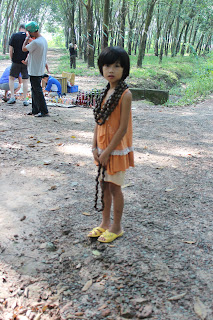Traveling along the Mekong River, we saw many barges carrying loads of gravel, soil, sand, rice, fruits, and more, such as this load of rice husks. The visit to the rice factory a day or two earlier (all time is beginning to merge for us!), showed how every bit of the rice is used -- polished for sticky rice, brown rice for other dishes, broken rice for flour and rice husks for fuel.
 |
| Barges carry the husks of rice to the factory for fuel. |
 |
| Rice husks are a much cheaper source of fuel than coal or gas. |
Because rice husks burn at a much lower temperature than coal or gas, the bricks must be fired a much longer time -- up to 45 days, with another week to cool. The ash is then sold to farmers to be used as fertilizer.
 |
| Unfired bricks covered a large portion of the floor. |
The open core of the bricks makes them lighter, to be used for upper story of buildings. In buildings we saw under construction, it looked as if rebar was only used at occasional joints. Asked about earthquake stability, Huy said this area -- unlike the Pacific Rim -- is not subject to earthquakes. Nevertheless, I wonder about building codes. (Things like steps are irregular in their risers; ramps are certainly not ADA compliant; setbacks are non-existent. Many aspects differ from US zoning and building codes.)
 |
| Two women load fired bricks into a wagon to stack by the dock. |
These women were loading fired bricks into a cart, then pulling it to unload near the dock for transport to the next buyer.
 |
| One enormous room had kilns lined up on both sides. |
Each kiln can hold up to 100,000 bricks -- these are huge! Similar in design to the bee hive oven that is part of our 18th century fireplace, but monumentally larger. None were in use when we visited, but I can only begin to imagine how hot this area gets when they are firing.
 |
| Each kiln had a small alcove where incense is burned as an offering. |
The inside of the kilns was as artful as the exterior -- the hole at the top probably 15 feet or more above the floor.
 |
| Inside one of the kilns. |
One kiln was in the process of being loaded -- the other piece of machinery (other than the extruder) was a narrow conveyor belt a portion of which you can see at the upper left of the photo below. One man stands at the bottom loading bricks onto it, another climbs up inside to stack the bricks. The hole is covered, rice husks tucked into the slots at the bottom, and once the fire is set everything is closed up for a month and a half, with occasional refueling.
 |
| Kiln being loaded with bricks to be fired. |
 |
| Steps built into the outside of the kiln allow workers to climb up and open the vent to cool bricks. |
We moved into an adjacent building, and discovered that bricks were not the only thing made in this factory. Piles of gnomes, shells, decorative motifs, and endless stacks of garden pots and other ornaments awaited shipping, or perhaps glazing or painting in another shop.
 |
Not just bricks!
|
 |
Many styles of garden ornaments and pots.
|
 |
| As with rice fields, a grave may be auspiciously placed right in the middle of a factory. |
Despite the presence of graves honoring ancestors showing up mid-rice field, farmland, and other places that might seem random to us but are carefully sited by fortune tellers (a mainstay of Vietnamese culture), I was surprised to see this rather magnificent grave in the middle of the storehouse.
I found the carts particularly photogenic, but they also indicate the number of workers who would be here on a normal production day.



























